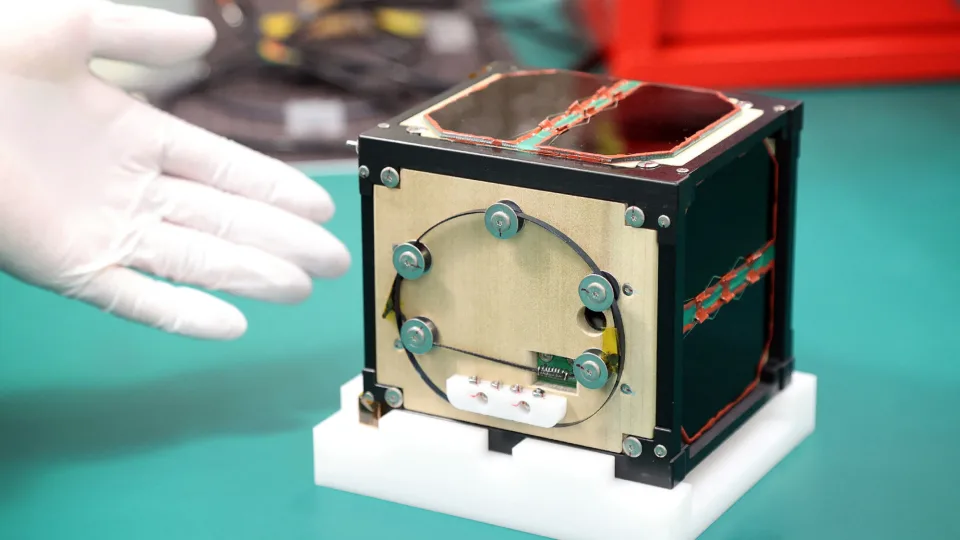In a historic step forward for sustainable space technology, Japanese scientists recently launched the world’s first wooden satellite, LignoSat, into orbit. Created by Kyoto University in partnership with Sumitomo Forestry, LignoSat was launched as part of a SpaceX mission to the International Space Station (ISS) and is now poised to demonstrate the potential of wood as a viable material for space exploration. This milestone represents more than just an experiment; it may lay the groundwork for a future in which wooden structures orbit Earth and, possibly, even help us build homes on the moon or Mars.
Why Send a Wooden Satellite to Space?
The launch of LignoSat aims to answer critical questions about wood’s durability in the extreme conditions of space. The experiment will test how wood withstands factors like cosmic radiation, microgravity, and the absence of moisture and oxygen. If the results prove favorable, it could pave the way for more wooden constructions in space, offering an alternative to traditional metal-based satellites.
Takao Doi, an astronaut and researcher at Kyoto University, explained the broader vision: “With timber, a material we can produce by ourselves, we will be able to build houses, live, and work in space indefinitely.” Doi and his team envision a future where timber structures become a staple in off-Earth habitats—a vision that aligns with Japan’s 50-year plan to create wooden habitats in space.
The Benefits of Wood in Space
Wood may seem like an unlikely choice for a satellite material, but it offers several surprising benefits. Unlike traditional metal, wood won’t corrode or degrade in the vacuum of space, where there is no moisture or oxygen. This makes it extremely durable in a way that terrestrial structures would not be. In addition, wood is non-conductive, a property that can protect satellites from some radiation exposure. Koji Murata, a forest science professor at Kyoto University, emphasized the feasibility of the idea, drawing comparisons to early 20th-century airplanes constructed from wood.
Wood also carries environmental advantages. While metal satellites typically burn up on reentry, releasing harmful particles such as aluminum oxide into the atmosphere, a wooden satellite would create minimal pollution as it disintegrates. This quality is especially significant as Earth’s orbit becomes increasingly crowded with space debris from more than 3,000 active satellites and countless fragments of decommissioned equipment.
A Solution to Space Debris?
One of the most pressing concerns surrounding current satellite technology is the growing issue of space debris. Earth’s low orbit is already cluttered with defunct satellites and debris that risk collisions with active equipment and space missions. Traditional metal satellites burn up upon reentry, but they often leave behind harmful particles. By contrast, wooden satellites could offer a more eco-friendly solution as they naturally decompose without creating hazardous debris.
This innovation aligns with Takao Doi’s vision of a future where metal satellites could potentially be replaced by wooden alternatives. Such a shift could help reduce the accumulation of hazardous materials in space, addressing a problem that has been largely overlooked in the rush toward space exploration.
A Timely Innovation for the Space Industry
The development of wooden satellites speaks to a broader trend in the space industry: the shift towards sustainability. As space missions increase in number, the focus is also turning toward materials and technologies that lessen our environmental impact. LignoSat could serve as a catalyst for more eco-conscious designs in the field, promoting sustainable approaches that benefit both space and Earth.
In a world where natural resources are increasingly precious, wood is a renewable and accessible material that could transform the economics of space missions. Its adaptability also makes it an attractive option for constructing space habitats, a vision that Takao Doi and his team at Kyoto University believe could eventually include “log cabins” on the moon.
Imagining Timber Habitats on the Moon and Beyond
As researchers like Doi look to the future, they see timber playing a pivotal role in the construction of space habitats. The lightweight, versatile, and durable nature of wood could make it ideal for crafting shelters in extreme environments. A structure made from wood, for instance, would be easier and cheaper to transport to the moon or Mars than many alternatives, potentially serving as a foundation for future bases or communities in space.
The possibilities for wooden structures in space also evoke memories of early aviation when wood was a mainstay in aircraft design. While the materials used in aviation have evolved over the years, the logic behind using wood remains sound. It’s relatively inexpensive, abundant, and has qualities that can stand up to the challenges of space.
What’s Next for Wooden Satellites?
The launch of LignoSat may mark just the beginning of an era in which wooden satellites and structures become a common sight in Earth’s orbit. If successful, this experiment could pave the way for further research and development into using wood for other spacecraft, possibly leading to future satellites and even space stations crafted from sustainable materials.
Looking ahead, Japan’s innovation could inspire other countries and private companies to consider alternatives to traditional satellite materials, sparking a wave of research into sustainable designs for space exploration. The wooden satellite could symbolize not just a scientific achievement but a new way of thinking about how we interact with and protect the space around our planet.
The Potential Impact on Future Generations
For future generations, the launch of the world’s first wooden satellite serves as a reminder that innovation doesn’t always require high-tech materials. Sometimes, the answers to today’s challenges lie in revisiting ancient resources like timber, whose properties are only now being fully appreciated in a space context. Should wooden satellites prove viable, they could inspire more environmentally friendly approaches across industries, both on Earth and beyond.
As Kyoto University and Sumitomo Forestry continue to monitor LignoSat’s performance, they are setting a precedent for what might become the new normal in satellite design. The success of this mission could lead to more sustainable, eco-friendly technologies in space exploration, making a significant impact on how we address space’s unique challenges.
Japan’s launch of LignoSat is more than a scientific milestone; it’s a bold exploration of what’s possible when we prioritize sustainability in our journey beyond Earth. If this experiment proves successful, it may redefine our approach to space technology, favoring materials that are both innovative and respectful of our environment. In the future, a constellation of wooden satellites orbiting Earth could symbolize humanity’s commitment to innovation and sustainability.
In embracing wood as a material for space technology, Japan is not only expanding the boundaries of what we think is possible but also inspiring the global space community to consider environmentally friendly solutions. As this project unfolds, the world will be watching closely, eager to see how wood stands up to the ultimate test.





